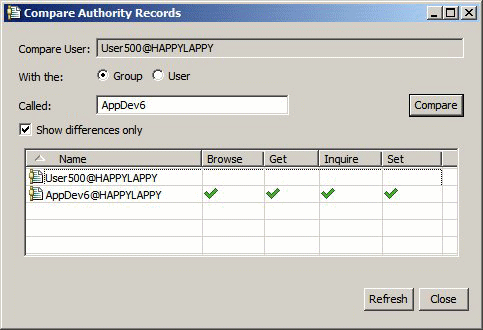Comparing the authorities of two entities
In the authorization service, we can compare the authorities that have been granted to two groups of users.
About this task
An example of the authorities that you could compare is to compare the authorities of group AppDev6 with the authorities of SysDev6 on queue Q_STOCKS_5.
On Windows queue managers, we can also compare the authorities that have been granted to two individual users, or compare the authorities of a group with the authorities of an individual user.
To compare the authorities of two groups or users, complete the following steps.
Procedure
- In the Content view, right-click the object on which the two groups or users have authorities, then click Object Authorities > Manage Authority Records... The Manage Authority Records dialog opens.
- Click the profile (generic profile or specific profile) that matches the objects on which the two groups or users have authorities. The authority records associated with the profile are displayed.
- Click the authority record of one of the groups or users, then click Compare The Compare Authority Records dialog opens.
- Enter the name of the group or user with which you want to compare authorities, then click Compare. The two groups or users and their authorities are displayed in the table.
- Optional: To show only the authorities that are set differently,
select the Show differences only check box.
The authorities that are the same for both groups or users are hidden
so that we can see the differences more easily. In the following
figure, the Compare Authority Records dialog shows that the only differences
between the authority records of the user called User500 and the
group called AppDev6 are that the Browse, Get, Inquire, and Set authorities
have been granted explicitly to AppDev6 but not to User500.

Results
The dialog displays only the authority records for the entities on the object. The dialog does not display authorities that the user or group might inherit from other sources (the accumulated authorities). For more information about comparing accumulated authorities, see Comparing the accumulated authorities of two entities.